ARTICLE AD BOX

Burmese pythons are remarkable predators capable of swallowing prey whole, from fur to bones. Yet, when they excrete, no skeletal remains are visible in their faeces. For years, this puzzled scientists who wondered how these massive snakes managed to digest bones so effectively.
Recent research has uncovered the answer: a newly discovered specialised cell in their intestines. These cells collect excess calcium and phosphorus from bones, wrapping them into tiny particles for safe excretion. This unique adaptation not only prevents mineral overload but also explains the python’s extraordinary digestive power, making them among nature’s most efficient hunters.
Why Python poop contains no bones: Scientists discover specialised cells

When Burmese pythons eat, they swallow everything: fur, flesh, and even bones.
Yet, their droppings show no trace of skeletal remains. The secret lies in a newly discovered special cell type within their intestinal lining.These cells create tiny spherical particles, called spheroids, which are made up of calcium and phosphorus layered around an iron-rich core. Instead of retaining or being harmed by these excess minerals, the python’s body wraps them into these spheroids and excretes them efficiently.
This adaptation allows the snake to eliminate bones seamlessly, leaving no skeletal fragments behind.
How researchers discovered the bone-digesting cells in Burmese Pythons
In groundbreaking research titled “Diet-dependent production of calcium- and phosphorus-rich ‘spheroids’ along the intestine of Burmese pythons: identification of a new cell type?", scientists explored how different diets affect bone digestion in these snakes. They tested pythons under four feeding regimes, whole rodents, boneless prey, boneless prey with added calcium, and fasting. The astonishing results revealed that the special spheroid-producing cells in the intestinal lining only appeared when the snakes consumed bone or calcium-rich meals.
When fasting or fed boneless prey, these cells and the mineral spheroids were entirely absent.Researchers studied Burmese pythons under different feeding conditions:
- Snakes fed whole rodents (including bones)
- Snakes fed boneless prey
- Snakes fed boneless prey with added calcium
- Snakes that were fasting
How the special cells work in Python digestion
Unlike regular intestinal cells that absorb nutrients, these newly identified cells are long and narrow, with small crypts inside them. Within these crypts, spheroids of calcium and phosphorus gradually form in concentric layers, a process similar to how snowflakes grow around a speck of dust.This unique adaptation helps Burmese pythons in three key ways:
- Efficient absorption of minerals such as calcium, which is vital for strong bones and teeth.
- Prevention of mineral overload, which could otherwise damage their organs and be toxic.
- Safe excretion of excess minerals in their faeces, leaving behind no visible bones.
Why bone-digesting cells matter: Evolution, adaptation, and survival
The discovery of these cells has huge implications:1. Explains bone digestion in snakesIt finally solves the mystery of how pythons digest entire skeletons, including teeth and skull bones, without leaving evidence in their droppings.2. Shows evolutionary adaptationThese specialised cells are not limited to pythons. They have also been found in other reptiles such as boas, Gila monsters, and possibly even in bone-eating birds like vultures.
This suggests a wider evolutionary strategy among species that swallow prey whole.3. Highlights snake survival skillsBy efficiently handling bone digestion, pythons can thrive in diverse environments. This ability helps explain why invasive species like Burmese pythons adapt so successfully in ecosystems such as the Florida Everglades.Also read | Labord’s Chameleon: The colour-changing lizard that lives for just four months



.png)
.png)
.png)
















 7 hours ago
4
7 hours ago
4








 English (US) ·
English (US) ·